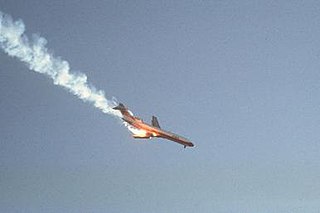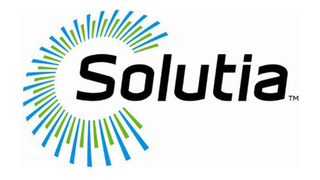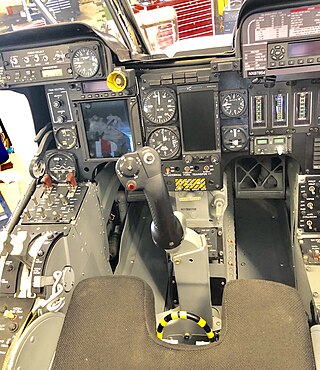Related Research Articles

A hydraulic fluid or hydraulic liquid is the medium by which power is transferred in hydraulic machinery. Common hydraulic fluids are based on mineral oil or water. Examples of equipment that might use hydraulic fluids are excavators and backhoes, hydraulic brakes, power steering systems, automatic transmissions, garbage trucks, aircraft flight control systems, lifts, and industrial machinery.

Pacific Southwest Airlines (PSA) Flight 182 was a scheduled flight of Pacific Southwest Airlines from Sacramento to Los Angeles and San Diego. On September 25, 1978, the Boeing 727-214 serving the flight, registration N533PS, collided with a private Cessna 172 light aircraft, registration N7711G, over San Diego, California. It was Pacific Southwest Airlines' first fatal accident, and it remains the deadliest air disaster in California history. At the time, it was the deadliest air crash in American history, and would remain so until American Airlines Flight 191 in May 1979.

Solutia Inc. was an American manufacturer of materials and specialty chemicals including polyvinyl butyral (PVB), ethylene vinyl acetate (EVA), and thermoplastic polyurethane (TPU) interlayers for laminated glass, aftermarket window films, protective barrier and conductive films, and rubber processing chemicals. The company was formed on September 1, 1997, as a divestiture of the Monsanto Company chemical business. In July 2012, the company was acquired by Eastman Chemical Company.
Bleed air is compressed air taken from the compressor stage of a gas turbine upstream of its fuel-burning sections. Automatic air supply and cabin pressure controller (ASCPCs) valves bleed air from high or low stage engine compressor sections. Low stage air is used during high power setting operation, and high during descent and other low power setting operations. Bleed air from that system can be utilized for internal cooling of the engine, cross-starting another engine, engine and airframe anti-icing, cabin pressurization, pneumatic actuators, air-driven motors, pressurizing the hydraulic reservoir, and waste and water storage tanks. Some engine maintenance manuals refer to such systems as "customer bleed air". Bleed air is valuable in an aircraft for two properties: high temperature and high pressure.

Aerial firefighting also known as Waterbombing is the use of aircraft and other aerial resources to combat wildfires. The types of aircraft used include fixed-wing aircraft and helicopters. Smokejumpers and rappellers are also classified as aerial firefighters, delivered to the fire by parachute from a variety of fixed-wing aircraft, or rappelling from helicopters. Chemicals used to fight fires may include water, water enhancers such as foams and gels, and specially formulated fire retardants such as Phos-Chek.

Jet fuel or aviation turbine fuel is a type of aviation fuel designed for use in aircraft powered by gas-turbine engines. It is colorless to straw-colored in appearance. The most commonly used fuels for commercial aviation are Jet A and Jet A-1, which are produced to a standardized international specification. The only other jet fuel commonly used in civilian turbine-engine powered aviation is Jet B, which is used for its enhanced cold-weather performance.
Brake fluid is a type of hydraulic fluid used in hydraulic brake and hydraulic clutch applications in automobiles, motorcycles, light trucks, and some bicycles. It is used to transfer force into pressure, and to amplify braking force. It works because liquids are not appreciably compressible.

Diammonium phosphate (DAP; IUPAC name diammonium hydrogen phosphate; chemical formula (NH4)2(HPO4) is one of a series of water-soluble ammonium phosphate salts that can be produced when ammonia reacts with phosphoric acid.

Tributyl phosphate, known commonly as TBP, is an organophosphorus compound with the chemical formula (CH3CH2CH2CH2O)3PO. This colourless, odorless liquid finds some applications as an extractant and a plasticizer. It is an ester of phosphoric acid with n-butanol.

Phos-Chek is a brand of long-term fire retardants, class A foams, and gels manufactured by Perimeter Solutions, headquartered in Clayton, Missouri.

A fire retardant is a substance that is used to slow down or stop the spread of fire or reduce its intensity. This is commonly accomplished by chemical reactions that reduce the flammability of fuels or delay their combustion. Fire retardants may also cool the fuel through physical action or endothermic chemical reactions. Fire retardants are available as powder, to be mixed with water, as fire-fighting foams and fire-retardant gels. Fire retardants are also available as coatings or sprays to be applied to an object.

Chlorendic acid, or 1,4,5,6,7,7-hexachlorobicyclo[2.2.1]-hept-5-ene-2,3-dicarboxylic acid, is a chlorinated hydrocarbon used in the synthesis of some flame retardants and polymers. It is a common breakdown product of several organochlorine insecticides.

Monoammonium phosphate, ABC Dry Chemical, ABC Powder, tri-class, or multi-purpose dry chemical is a dry chemical extinguishing agent used on class A, class B, and class C fires. It uses a specially fluidized and siliconized monoammonium phosphate powder. ABC dry chemical is usually a mix of monoammonium phosphate and ammonium sulfate, the former being the active component. The mix between the two agents is usually 40–60%, 60–40%, or 90–10% depending on local standards worldwide. The USGS uses a similar mixture, called Phos Chek G75F.

A turbine engine failure occurs when a turbine engine unexpectedly stops producing power due to a malfunction other than fuel exhaustion. It often applies for aircraft, but other turbine engines can fail, like ground-based turbines used in power plants or combined diesel and gas vessels and vehicles.

Triphenyl phosphate (TPhP) is the chemical compound with the formula OP(OC6H5)3. This colourless solid is the ester (triester) of phosphoric acid and phenol. It is used as a plasticizer and a fire retardant in a wide variety of settings and products.
Therminol is a synthetic heat transfer fluid produced by Eastman Chemical Company.

Aircraft systems are those required to operate an aircraft efficiently and safely. Their complexity varies with the type of aircraft.
Aerotoxic syndrome relates to ill-health effects that are claimed to be caused by breathing contaminated airliner cabin air. Researchers have associated aerotoxic syndrome with exposure to substances such as engine oil and hydraulic fluids. Although researchers have identified correlations between the aircraft occupational environment and aerotoxic syndrome’s symptoms, this condition is not an established medical diagnosis, because the condition’s incidence and aetiology are still under debate.

Marvel Mystery Oil is an automotive product of the American Marvel Oil Company, founded by Burt Pierce in 1923. It is used as a fuel additive, oil additive, corrosion inhibitor, penetrating oil, and transmission leak stopper and seal relubricator.

A fume event occurs when bleed air used for cabin pressurization and air conditioning in a pressurized aircraft is contaminated by fluids such as engine oil, hydraulic fluid, anti-icing fluid, and other potentially hazardous chemicals.